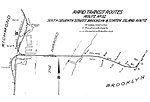The Staten Island Tunnel is an abandoned, incomplete railway/subway tunnel in New York City. It was intended to connect railways on Staten Island (precursors to the modern-day Staten Island Railway) to the BMT Fourth Avenue Line of the New York City Subway, in Brooklyn, via a new crossing under the Narrows. Planned to extend 10,400 feet (3,200 m), the tunnel would have been among the world's longest at the time of its planning, in the late 19th and early 20th centuries.
Construction began in 1923, and the tunnel was excavated 150 feet (46 m) into the Narrows before New York City Mayor John Hylan, a former Brooklyn–Manhattan Transit Corporation (BMT) employee and initial proponent of the tunnel, canceled the project in 1925. The tunnel lies dormant under Owl's Head Park in Bay Ridge, Brooklyn. Later proposals to complete the tunnel, including the 1939 plans for the Independent Subway System's ambitious Second System, were never funded.
Modern proposals for completion of the tunnel have come from New York City Councilman Lewis Fidler, who in 2007 proposed a 0.33% tax for the tri-state region to pay for the construction. The tunnel was listed as one of many projects that could receive federal funds that were to have been allocated to the Access to the Region's Core tunnel, which was canceled in October 2010. State Senator Diane Savino was among the supporters of the tunnel; Savino stated that if built, the tunnel would cost $3 billion and would improve quality of life for Staten Islanders, reduce traffic, and increase the attractiveness of the borough for investment.










